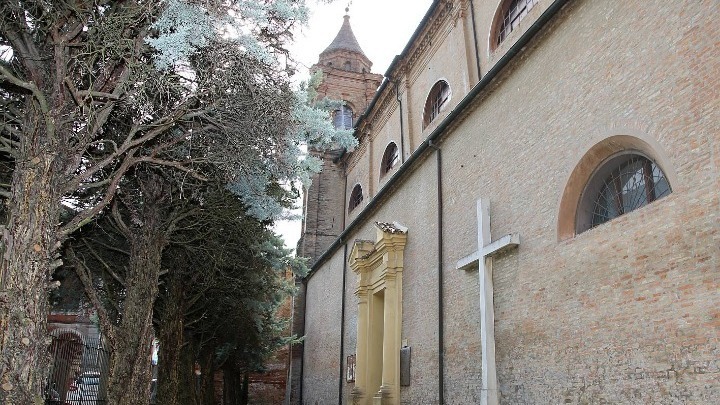The mystery surrounding the fate of the body of Allegra Byron, daughter of Lord Byron and Claire Clermont, who died in an Italian monastery aged five, is back in the news after the discovery of the monastery’s archive, as presented at the 48th International Byron Conference in Missolonghi.
The unfortunate Allegrina died on April 20, 1822 of an undetermined epidemic, probably typhoid or malaria, at the nunnery of Bagnacavallo near Ravenna. Lord Byron had entrusted his daughter, the result of his troubled relationship with Claire Clairmont, to the convent to receive a good upbringing and education, as the convent was run for financial reasons as a boarding school as well. This choice of his proved fatal.
In a letter to his editor, John Murray, two days after Allegra’s death, the poet explained that it was his wish to send the girl’s remains to England to be buried in the churchyard of Harrow, the school he had attended, also “where I once hoped to have laid my own”. The child’s body was “embalmed and in lead” he noted – while in the postscript to his letter, presumably to secure easier acceptance of his request, he added: “You are aware that protestants are not allowed holy ground in Catholic countries”.
According to the official narrative, the coffin with Allegra’s body travelled to England, but the vicar of the church refused to allow the illegitimate daughter of a scandalous poet to be buried in the Christian cemetery. The girl was buried near the church in an unknown place. No tombstone indicates where her body was buried.
Allegra’s mother never stopped blaming Byron for his decision to send her daughter to the monastery. The two had separated, their relations were already nearly hostile, and Byron stubbornly refused to allow her to visit her daughter. As Daisy Hay informs us in her book “Young Romantics: The Shelleys, Byron and Other Tangled Lives”, Claire Clairmont later conceived the paranoid notion that “Allegra had not died in 1822, but that Byron, in the spirit of absolut villainy, decided to convince Clara of her demise by sending a goat in a child’s coffin to England.”
But here’s why, according to research presented at the International Association of Byron Societies conference by Fernando Valverde, associate professor of Spanish Literature at the University of Virginia and former journalist for the Spanish “El Pais”, it is very likely that Allegra was not buried in Britain, but is buried in a chapel of the Italian convent.
The archives of the Bagnacavallo Monastery remained inaccessible, despite repeated attempts by the international Byronic community to gain access to them. A few years ago the monastery ceased to function and its property passed on to a Belgian company. In 2020, during the pandemic that had led to the temporary cessation of the evacuation of the buildings, Mr. Valverde and his wife, Prof. Nieves Garcia Prados, were able, through persistent fieldwork in the area, to gain access to the archive and photograph the material of the period 1820-1822 relating to the unfortunate girl.
“Due to the epidemic that caused Allegra’s death, the Italian authorities would have been unable to allow a body to travel all the way to England,” Prof. Valverde believes. “Even in the case of Percy Shelley, who drowned in the Adriatic, his body, after being pulled from the water, was burned. I see no reason why an exception should have been made in the case of Allegra.”
Α nun of the Bagnacavallo Monastery indeed notes in a letter that the girl never left the monastery and that she is buried under an altar in the chapel of the Virgin of Lourdes. On the other hand, however, the abbess of the convent, in a letter to a teacher at the boarding school, appears to state that Allegra’s body left Livorno for England and that the ship carrying her sank in the Adriatic Sea. “The paradox in this case is that the site of the alleged shipwreck is close to where Shelley drowned,” notes Valverde.
The revelation of the convent’s documents seems to add to the mystery already shrouding the death of little Allegra and is expected to trigger a new round of discussions in the field of Byronic studies – and beyond. Did Allegrina’s body travel to England, and where is it buried? If it never arrived, whom should we believe? The abbess who seems to claim that the girl’s body sank in the waters of the Adriatic, or the nun who also points out her grave? And if either woman is lying, what exactly is the reason?
Allegrina was the result of a troubled relationship that was steeped in bitterness and hatred. Young people, Byron, Shelley, Mary Shelley, Claire, experimented with ideals and choices – free love, shared parenting, liberalism and political radicalism – that brought them into conflict with the establishment of their time and even with themselves. This conflict left them self-wounded as well. As Byron noted of his dead child in a letter to Sir Walter Scott on May 4, 1822, “The only consolation, save time, is the reflection, that she is either at rest or happy; for her few years (only five) prevented her from having incurred any sin, except what we inherit from Adam.” And he concluded his report with a line from Shakespeare’s Macbeth: ‘Whom the gods love, dies young’.
Perhaps this is the same thought the sisters of the Convent of St. John the Baptist, in the small village outside Ravenna, also had. Perhaps they finally decided that the green pastures for the repose of an innocent creature, an unfortunate one but dear to God, was a crypt under their chapel.
SOURCE; ANA-MPA







